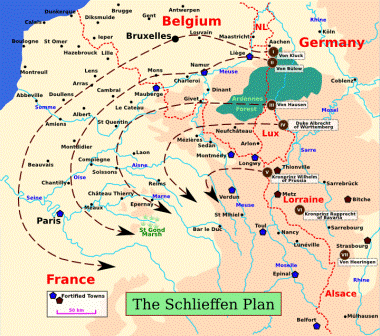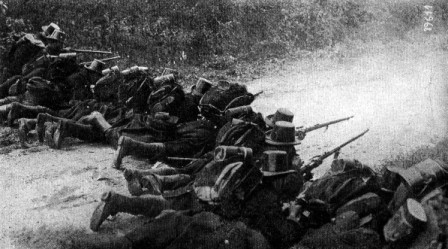The Treaty of London 1839-Guarantee of Belgian Neutrality
The 1839 Treaty of London set up Belgium as a nation independent of the Netherlands. The Belgians had achieved de facto independence in the 1830-1832 War of Independence with military aid from France. The Dutch monarch refused to accept Belgian independence until the Treaty of London in 1839. This treaty is most significant however, as the legal device whereby the United Kingdom felt it had to declare war against Germany in 1914. Article 7 of the treaty bound Britain to come to the aid of Belgium in the event of invasion by another power. This treaty committed Britain to guard the neutrality of Belgium in the event of the latter’s invasion.
[xyz-ihs snippet=”textlinkshorizontal2014″]
The German Government, intending to do just that so as to reach France (specifically Paris) all the faster in the opening weeks of the First World War, asked the British government in August 1914 to effectively ignore the “scrap of paper” committing Britain to the defense of Belgium. Britain refused. The German Army invaded Belgium as per their long-standing plans, and British Prime Minister Herbert Henry Asquith took Britain into the Great War on August 4, 1914. And, in the days of the old British Empire, as went Britain, so too went Canada, Australia, New Zealand, South Africa, and all the colonies and dependencies controlled by the British, including the massive colony of India. The act of Britain entering the war truly made this regional European conflict into a true World War.
The Text of the 1839 Treaty of London is below (excerpted)
——-
Treaty between Great Britain, Austria, France, Prussia, and Russia, on the one part, and The Netherlands, on the other.
Signed at London, 19th April, 1839
Reference to Treaties of 14th October, 1831; and 15th November, 1831
In the Name of the Most Holy and Indivisible Trinity
Her Majesty the Queen of the United Kingdom of Great Britain and Ireland, His Majesty the Emperor of Austria, King of Hungary and Bohemia, His Majesty the King of the French, His Majesty the King of Prussia, and His Majesty the Emperor of All the Russias, having taken into consideration their Treaty concluded with His Majesty the King of the Belgians, on the 15th of November, 1831; and His Majesty the King of the Netherlands, Grand Duke of Luxemburg, being disposed to conclude a Definitive Arrangement on the basis of the 24 Articles agreed upon by the Plenipotentiaries of Great Britain, Austria, France, Prussia, and Russia, on the 14th of October, 1831; their said Majesties have named for their Plenipotentiaries, that is to say:
Her Majesty the Queen of the United Kingdom of Great Britain and Ireland, the Right Honourable Henry John Viscount Palmerston, Baron Temple, a Peer of Ireland, a Member of Her Britannic Majesty’s Most Honourable Privy Council, a Member of Parliament, and Her Britannic Majesty’s Principal Secretary of State for Foreign Affairs, etc.;
His Majesty the Emperor of Austria, King of Hungary and Bohemia, the Sieur Frederic Christian Louis, Count de Senfft-Pilsach, Chamberlain and Privy Councillor of His Imperial and Royal Apostolic Majesty, and his Envoy Extraordinary and Minister Plenipotentiary to His Majesty the King of the Netherlands, etc.;
His Majesty the King of the French, the Sieur Horace Francis Bastien, Count Sebastiani-Porta, a Lieutenant-General in his armies, a Member of the Chamber of Deputies of France, his Ambassador Extraordinary and Minister Plenipotentiary to Her Britannic Majesty, etc.;
His Majesty the King of Prussia, the Sieur Henry William, Baron de Bülow, his Chamberlain, Privy Councillor of Legation, Envoy Extra-ordinary and Minister Plenipotentiary to Her Britannic Majesty, etc.;
His Majesty the Emperor of All the Russias, the Sieur Charles Andrew, Count Pozzo di Borgo, a General of Infantry in his Armies, his Aide-de-Camp General, Ambassador Extraordinary and Plenipotentiary to Her Britannic Majesty, etc.;
And His Majesty the King of the Netherlands, Grand Duke of Luxemburg, the Sieur Solomon Dedel, his Envoy Extraordinary and Minister Plenipotentiary to Her Britannic Majesty, etc.
Who, after having communicated to each other their Full Powers, found in good and due form, have agreed upon the following Articles.
…
Reciprocal Renunciation of Territories
Article 6
In consideration of the territorial arrangements above stated, each of the two Parties renounces reciprocally and for ever, all pretension to the Territories, Towns, Fortresses, and Places situated within the limits of the possessions of the other Party, such as those limits are described in Articles 1, 2, and 4.
The said limits shall be marked out in conformity with those Articles, by Belgian and Dutch Commissioners of Demarcation, who shall meet as soon as possible in the town of Maastricht.
Belgium to Form an Independent and Neutral State
Article 7
Belgium, within the limits specified in Articles 1, 2, and 4, shall form an Independent and perpetually Neutral State. It shall be bound to observe such Neutrality towards all other States.
Drainage of Waters of the Two Flanders
Article 8
The drainage of the waters of the Two Flanders shall be regulated between Holland and Belgium, according to the stipulations on this subject contained in Article 6 of the Definitive Treaty concluded between His Majesty the Emperor of Germany and the States-General, on the 8th of November, 1785, and in conformity with the said Article, Commissioners, to be named on either side, shall make arrangements for the application of the provisions contained in it.


